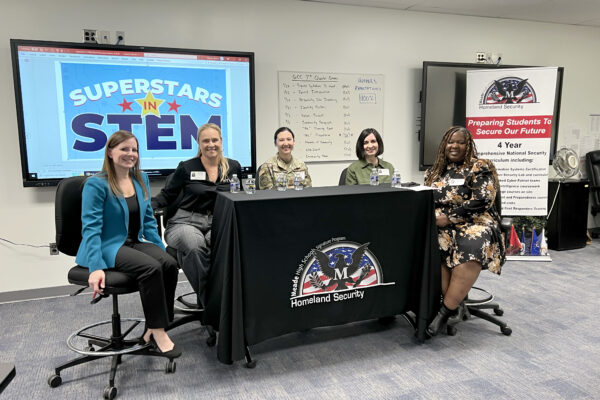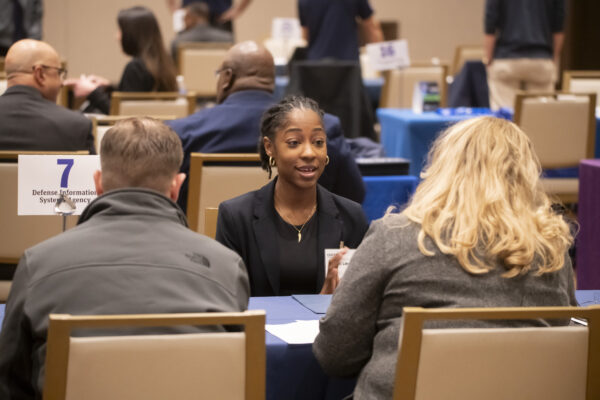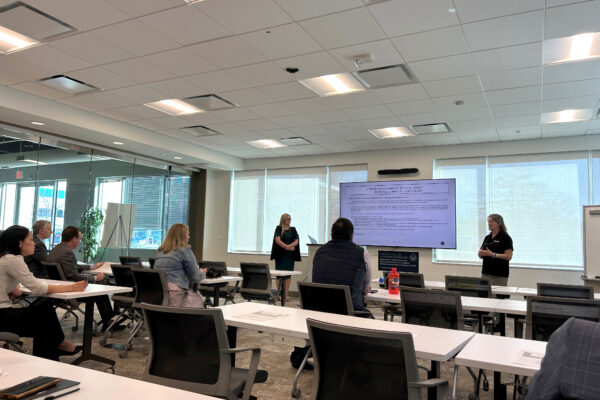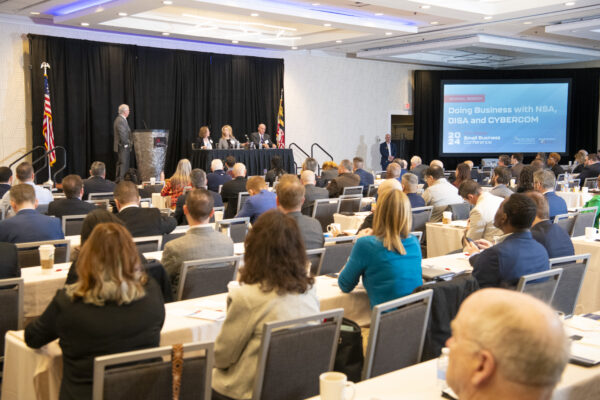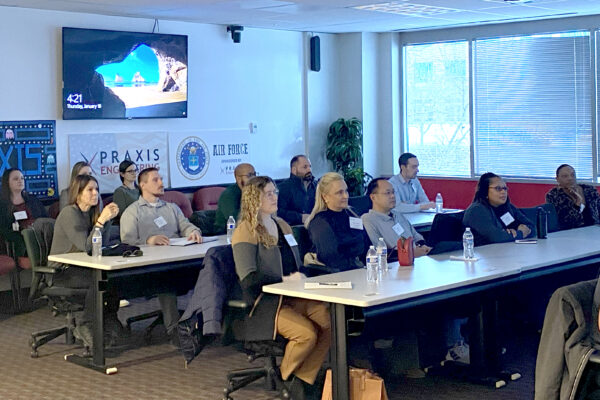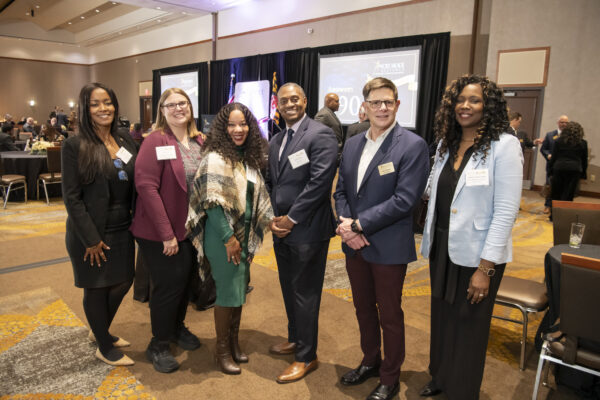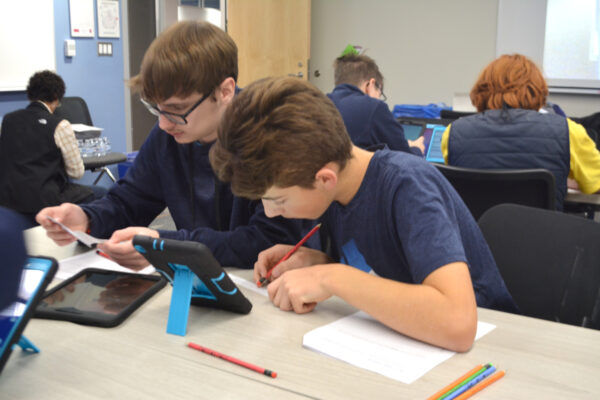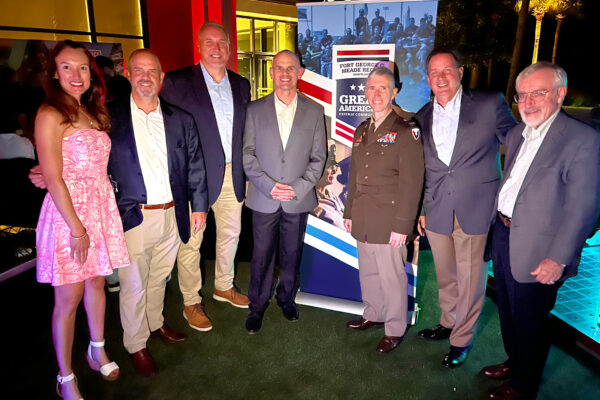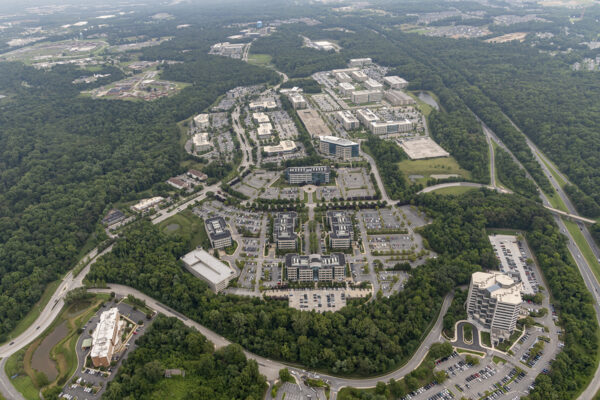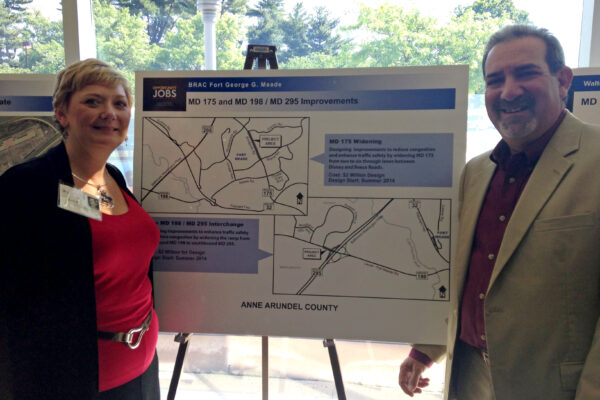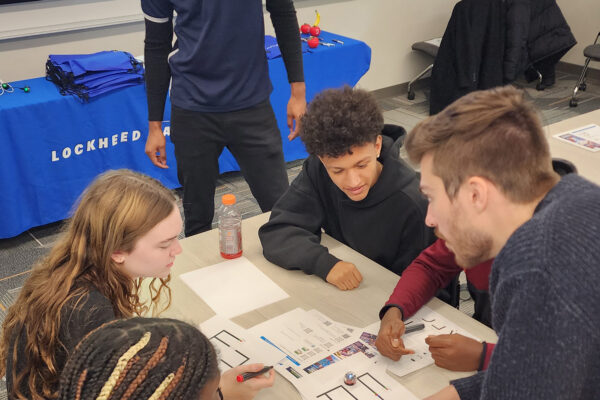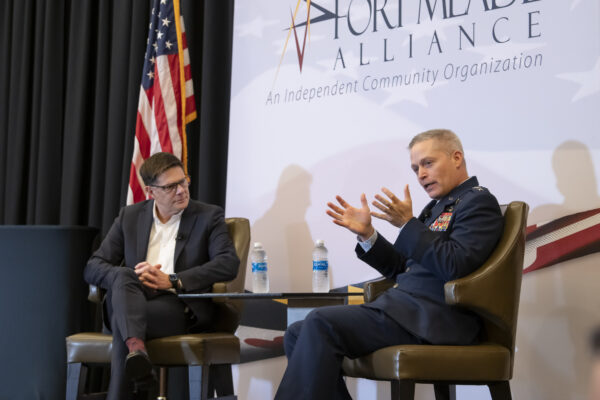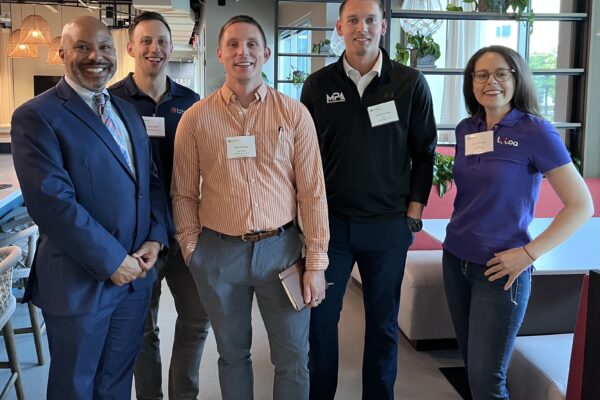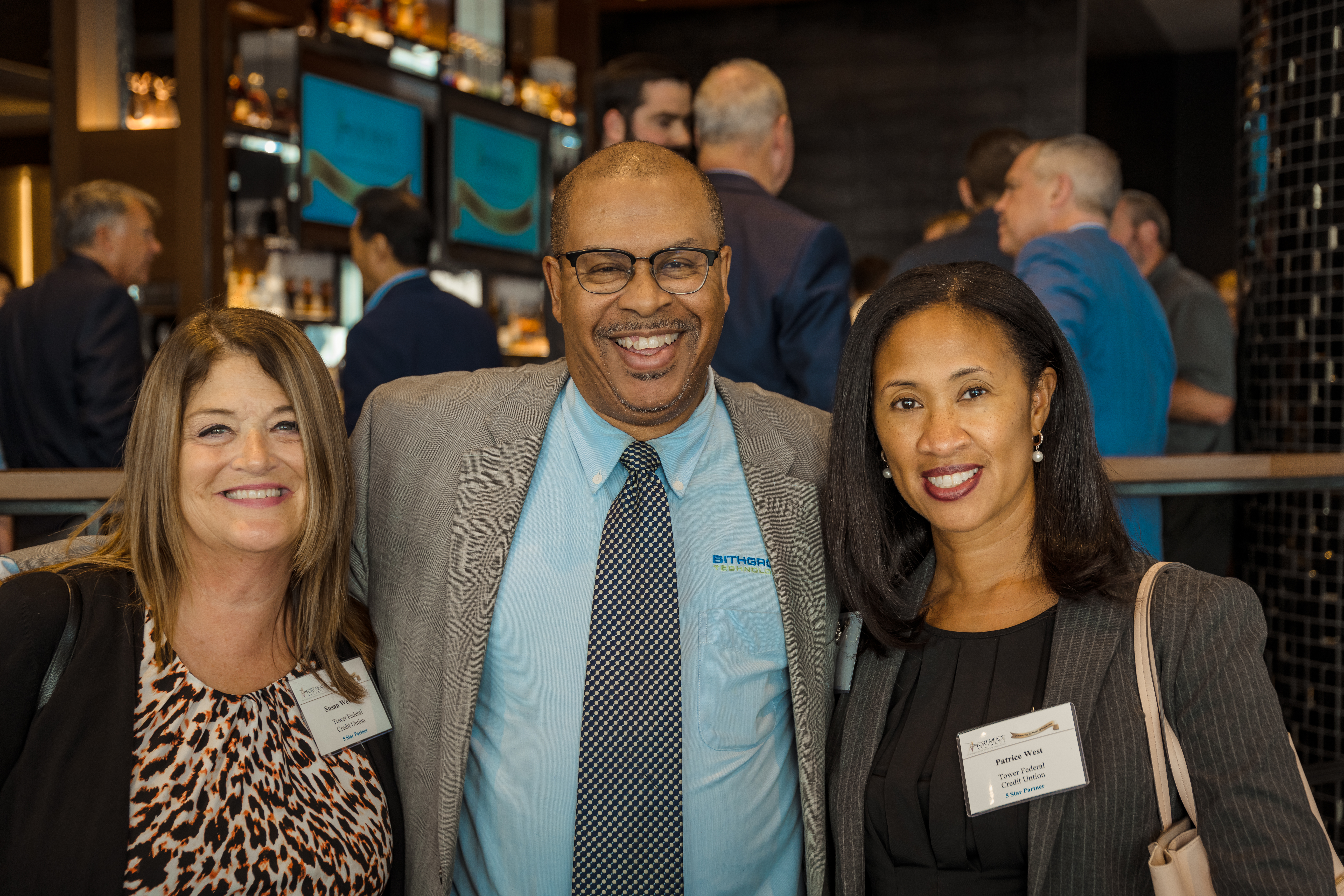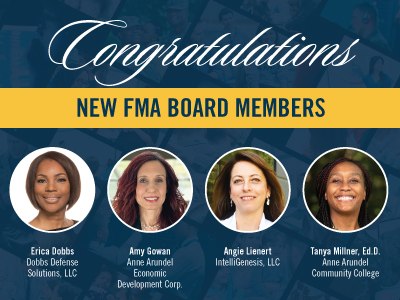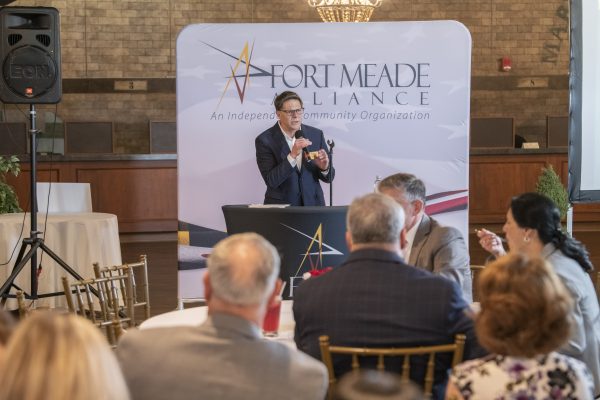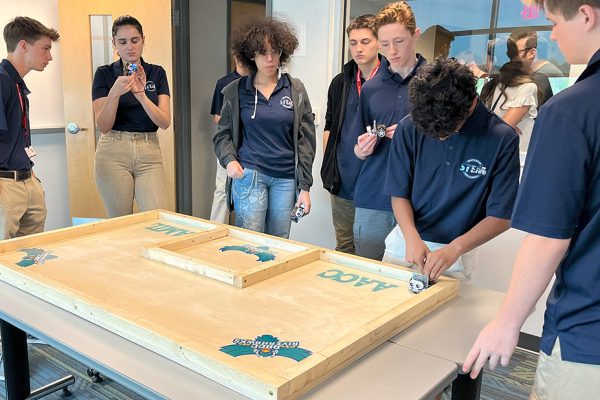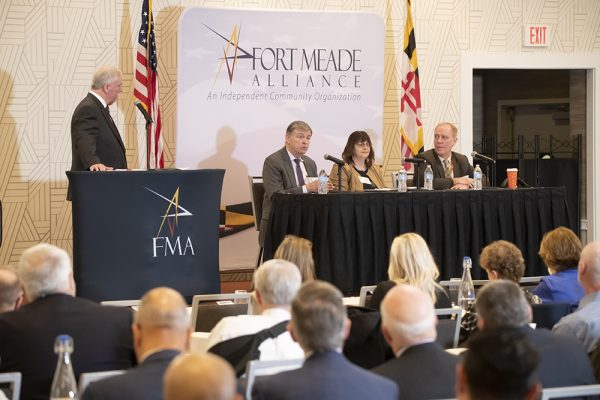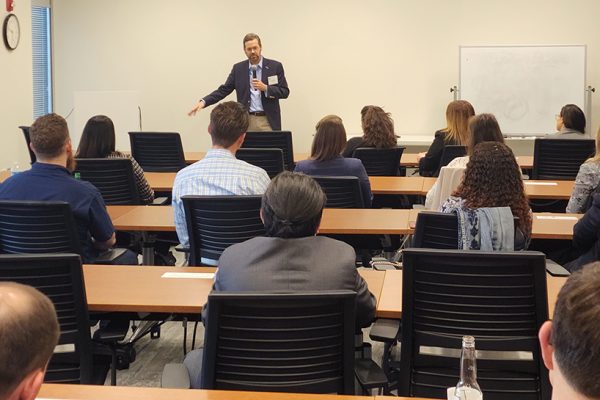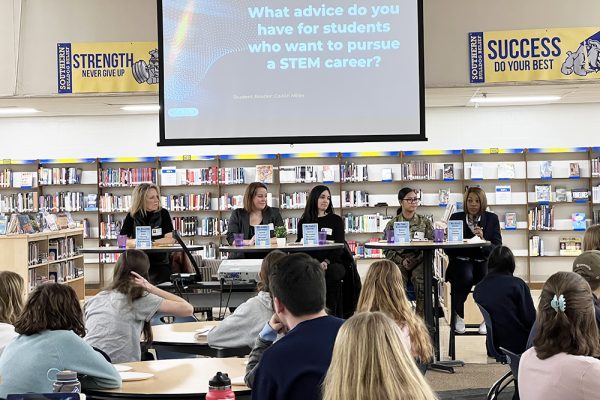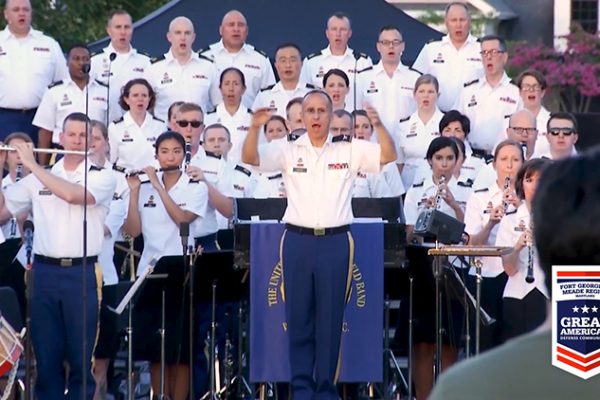The Fort Meade Alliance is dedicated to fulfilling a mission to support the work and people of Fort George G. Meade and help Fort Meade drive economic growth in Maryland. Our efforts on behalf of that mission generate real impact for our region through education and workforce development initiatives, business connections and DoD community support.
It started with a half-dozen military veterans and intelligence retirees huddled in the children’s room of the Odenton library.
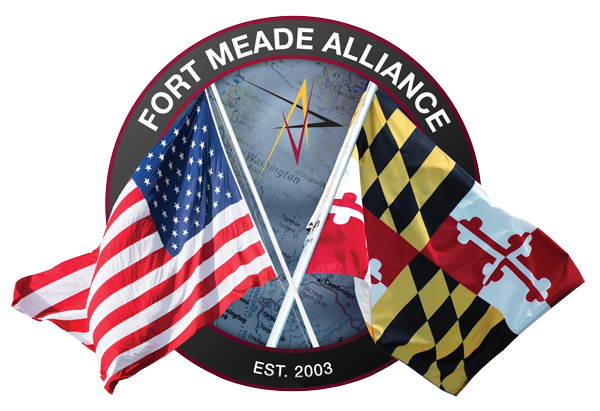
Almost twenty years ago, the Fort Meade Alliance began with a few committed individuals and a singular purpose. Maryland’s Department of Business and Economic Development (DBED) had been encouraging communities to form alliances to support military installations in the face of upcoming deliberations by the Base Realignment and Closure Commission (BRAC).

Bert Rice, one of the FMA’s original members, said he and a few other veterans had seen a previous BRAC decision downgrade Fort Meade’s hospital to an ambulatory care facility and wanted to ensure the next BRAC was more favorable to Fort Meade.
The original members met periodically at the Odenton Library with BGen (Ret) Mike Hayes, managing director of Maryland’s Office of Military and Federal Affairs who guided the creation of community alliances to support Maryland military installations. The new organization “stumbled along” as they sought information about BRAC and the Garrison, and began organizing support for Fort Meade, Rice said.
Col. (Ret) Kenneth McCreedy, Fort Meade’s Garrison commander from 2005-2008, said when he arrived on post, the FMA consisted of just six businesses. However, the group had made presentations to BRAC officials. Realizing Fort Meade would need ways of communicating and collaborating with the community once the BRAC decisions were announced, the new Garrison Commander began meeting with the Alliance and encouraging other community members to join.
Jay Baldwin, a banker with a curiosity about BRAC and how it would affect his community, was one of the new members who joined the Alliance in 2005.
“I showed up at a meeting and they immediately voted me as treasurer, without even asking, as a matter of fact,” said Baldwin, who eventually became president.
“The Alliance was small, underfunded and really living week to week from a financial perspective,” Baldwin said. “I looked at the numbers and decided we had to make some changes and grow the organization.”
“The Alliance advocates tirelessly for Fort Meade, ensuring that it has the resources it needs for its critical mission.”
Lifeline dollars and BRAC opportunities
The FMA soon attracted the support of then Anne Arundel County Executive Janet Owens and Bill Badger, then-CEO of the Anne Arundel Economic Development Corp.
Badger had been searching for a way to address the large but complex economic opportunity posed by Fort Meade. The installation was clearly a powerful economic force in West County. The growth of military contractors around Fort Meade had already spurred the development of National Business Park and Fort Meade-related work was driving the creation of leading edge technology and high-tech jobs. However, the secretive nature of the National Security Agency and some other Fort Meade agencies dampened knowledge about Post operations and the business opportunities there, Badger said.
The Fort Meade Alliance, he reasoned, could become a platform to bring federal officials, government contractors, technology innovators, various businesses, military supporters and community members together to share information and help the region flourish.
Owens and Badger provided office space and support to the Alliance, and enabled it to appoint its first executive director. Meanwhile, DBED awarded the FMA a $20,000 grant. “Those were lifeline dollars,” Baldwin said.
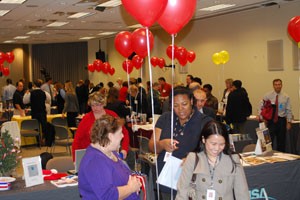
Those new resources and the BRAC decision to move three major agencies to Fort Meade soon fueled growth within the FMA. Regular meetings began to include the Garrison Commander, other Fort Meade officials, elected representatives from all levels of government and growing ranks of military contractors. The wealth of knowledge embodied in the FMA membership swelled and the Alliance started to be recognized as the go-to organization for information about Fort Meade.
Alliance members put that knowledge into action.“We were determined to become a living, breathing, doing organization,” Baldwin said.
Eager to support the missions of Fort Meade agencies, the FMA held widespread consultations about the intricacies, implications and challenges of BRAC.Realizing that many employees of BRAC agencies were unfamiliar and even anxious about moving to Maryland, the FMA hosted relocation fairs for affected staff from Defense Information Systems Agency (DISA), Defense Media Activity and DoD Adjudication.
It organized bus tours of Fort Meade and the surrounding community, and produced publications that provided information about transportation and commuting options, local schools and colleges, communities throughout the Fort Meade Region and entertainment and culture in Maryland.
“The Fort Meade Alliance has been instrumental in ensuring that the Installation receives the support and resources needed to carry out the Army mission.”
Planning for long-term impact
As the BRAC implementation progressed, the Alliance also looked outward. FMA leaders did not want to risk becoming a one-issue — and consequently, time-limited —organization. They wanted the FMA to have an enduring mission and long-lasting impact, so they recruited a brand new member, Rosemary Budd, to lead a committee to develop the FMA’s strategic plan.
For nine months, the committee conducted exhaustive interviews, surveys and working group sessions to “define our organization’s goals and objectives, but also who our stakeholders were,” Budd said. “We became clear about the fact that our stakeholders are the Garrison, the military and their families, the agencies and organizations on base, our members and the community. And those stakeholders, when it came to Fort Meade, all had different needs and we needed to be able to recognize those and tailor our programs and initiatives to make sure we were providing value.”
The strategic planning process also generated a rich understanding about the diversity and capabilities of FMA members.
“The strategic plan became about recognizing this diverse membership in support of these stakeholders and how everyone had a role to play,” said Budd, a former FMA President. “If we brought it all together, we would have a lot of power. For that reason, we could be a very impactful organization.”
Putting diversity to work
Harnessing that diversity in support of the Fort Meade Alliance’s mission has triggered a range of initiatives ever since.
FMA Education and Workforce Development Chair Penny Cantwell had been active in efforts to improve education in Anne Arundel County for years when then-FMA President Clemon Wesley urged her to join the Alliance. Cantwell had been trying to get local industries more involved with local schools in order to bring real-world relevance to the curriculum. Although businesses and schools wanted closer connections, they had vastly different ideas of what that involvement would look like. Consequently, partnering efforts kept lagging.
“When I came to the Fort Meade Alliance, I saw for the first time a real opportunity to get industry support [for education],” Cantwell said. “Because of the economic impact of Fort Meade and BRAC, I would be able to get industry to begin to impact curriculum and that impact would go well beyond books.”
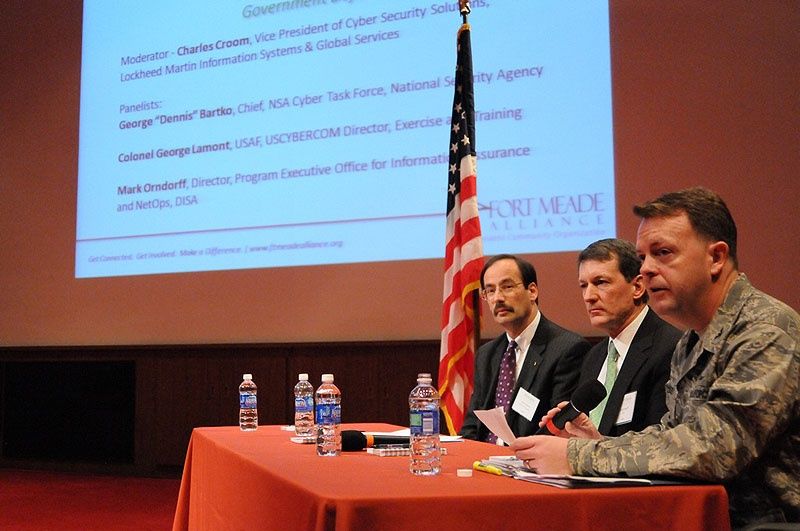
Realizing the power of bringing government, business, educators and others together in one room, the Alliance began to host forums about cyber, STEM education, health care and workforce development. Those forums brought together experts from a variety of fields, fueled thought-provoking discussions and resulted in detailed white papers that laid the groundwork for further FMA initiatives. To support essential education and workforce development in the region, the Alliance created Tech Mania, STEM Family Night and the incredibly successful Project SCOPE (Security Clearance Overview Preparation Education).
“This idea was spawned by an education forum and listening to our government stakeholders and the challenges they were facing,” said former FMA President Deon Viergutz. “We pulled together the unbelievable talents of the Alliance to build Project SCOPE then let it evolve. Now, Project SCOPE is in the curriculum of every public school through the State of Maryland. That is a huge success story that makes an enormous difference.”
“The Fort Meade Alliance has done any number of innovative things, some of which have become models that have extended across Maryland and beyond,” said Hayes. “It has become our largest alliance and, by far, our most active alliance in terms of interaction with the community and interaction with the base it supports.”
Improving Quality of Life at FGGM
Passionate about supporting service members, military families and civilian employees at Fort Meade, the Alliance began organizing holiday toy drives, supplying snacks to the Wounded Warriors Transition Unit (WWTU) and supporting other efforts to improve quality of life on Fort Meade. Then one day, an opportunity arose to launch the Alliance into a more ambitious project and a deeper partnership with Fort Meade.
Eager to do more for wounded warriors, Alliance members presented Col. (Ret) Daniel Thomas, Garrison Commander at the time, with a list of goods and services they would like to provide to improve the WWTU.
Thomas recalls reading through the list and responding, “Would you rather do something big?”
“At the time, I had a huge problem,” he said. Fort Meade’s population of wounded warriors had grown significantly, but the Garrison had not been designated as a long-term, official wounded warrior transition site.
“So, as a base, we had been given a mission but no resources,” Thomas said.
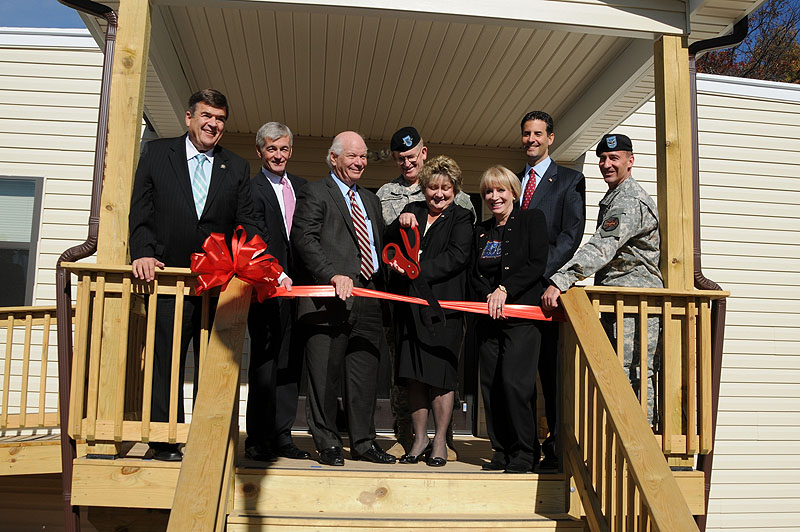
Thomas had pressed Army officials to approve funds for a Soldier and Family Assistance Center (SFAC) to help meet growing needs at Fort Meade. The approved budget of $800,000, however, seemed inadequate.
“To build and fully outfit a center within that budget, we would have to shrink it down and it really wouldn’t have done what it needed to do,” Thomas said. “So I made the decision to build it out as big as possible and worry about outfitting it later because I figured someone would do the right thing. So I told the FMA, if you want to do something big for wounded warriors, here’s your opportunity.”
Outfitting an entire SFAC was a huge undertaking and Thomas expected it would pose challenges to the Fort Meade Alliance. To help bring attention to the cause and aid fundraising, he organized a groundbreaking ceremony for the SFAC, “but heck, the FMA had already raised all the funds by the time we did the event,” he said.
“I don’t believe any other installation has an Alliance so robust and so dedicated to supporting its well being.” Col. Edward Rothstein, former Garrison Commander at Fort George G. Meade
A Refreshing Sense of Patriotism
That passion for Fort Meade and that commitment to providing excellent support has fueled numerous FMA initiatives, including Meade Business Connect and the Resiliency Campaign, that have strengthened the Fort Meade Region.
“We are a force multiplier,” Viergutz said. “We are excellent at organizing and partnering and driving towards an objective — it’s one of our greatest strengths. We deliver on our commitments, we always deliver the highest quality and, given the diversity of our membership, I believe there is not a problem that we can’t solve. And it all happens because this is a group of people who genuinely care. They roll up their sleeves and get things done.”
“It has always been heartwarming for me to see a group like the [Fort] Meade Alliance,” Thomas said. “You never got the sense that they are doing it because there is something in it for them. I truly think there is a sense of selfless service within the civilian membership and leadership of the Alliance because they care about our country. There is a refreshing sense of patriotism within this group.”
“The Alliance not only sets the standard regionally, but aspects of its work are now emulated across the nation.”
Poised for Greater Achievements
Through several initiatives in recent years, the Fort Meade Alliance has laid the groundwork for new and greater accomplishments in its next decade.
In 2011, the Alliance moved its headquarters into a conveniently located office in Hanover and contracted a professional association management company, the O’Ferrall Group. That professional assistance, Budd said, is enabling inspired individuals within the FMA’s leadership, committees and general membership to tackle ambitious projects and achieve more through their efforts.
In addition, in 2012 FMA members completed the final steps to establish the FMA Foundation, a 501c3 that greatly expands the Alliance’s ability to raise funds for various endeavors including the Fort Meade Resiliency Campaign Initiative.
Col. (Ret) Edward Rothstein, who completed his tour as garrison commander in mid-2013, said he had always been impressed by Alliance members’ strong commitment to Fort Meade and their willingness to roll up their sleeves and work to improve the post and the region. Yet even Rothstein was astounded by the Alliance’s offer to spearhead the resiliency campaign.
“In my wildest dreams, I never imagined that somebody would take this on so convincingly and be so committed to making this resiliency effort happen,” Rothstein said. “To me, Fort Meade’s partnership with the Fort Meade Alliance is an example to the entire Army of how garrisons partner with outside-the-fenceline organizations.”
Meanwhile, the FMA’s ongoing strategic planning process keeps the Alliance well positioned to address evolving and exciting opportunities as Fort Meade continues to grow and play a greater role in the region’s economy and the nation’s security.
With 116 federal agencies and military commands located on post, Fort Meade now ranks as the single largest employer in Maryland and supports $38 billion in economic activity annually. As the headquarters for the NSA and U.S. Cyber Command, Fort Meade has become the national center for information, intelligence and cyber, whose critical missions are expected to grow for years to come.
“We intend to remain 100 percent committed to our mission and our traditions of supporting Fort Meade,” Viergutz said. “This is an organization of active leaders and active members who live our motto of ‘Get connected, get involved, make a difference.’ Whether it’s addressing transportation issues, tackling education and workforce needs, developing the business community, understanding and advocating for the priorities of Fort Meade, or connecting with community partners, the Fort Meade Alliance will continue to make a positive and enduring impact on the Fort Meade Region.”
LATEST NEWS
Not your typical job fair
The inaugural Career Transition Showcase debuted Thursday, April 25 at the Live! Casino and Hotel providing nearly 100 transitioning military, military spouses and recent veterans with the opportunity to interview…
FMA mission inspires deep commitment by members
Driven by a clear mission, core passion and determination to deliver real impact, the Fort Meade Alliance has attracted long-standing support from a wide array of organizations, companies and accomplished…
FMA attends the ADC Conference
In early November, Fort Meade Alliance Foundation President Deon Viergutz and Fort Meade Alliance General Manager Tim O’Ferrall joined Fort Meade Garrison Commander COL Michael Sapp and Meade High School…
FMA helps companies support defense missions
One of the original members of the Fort Meade Alliance, COPT Defense Properties has come to regard the FMA as “the gold standard for community relations around a fort,” said…
FMA created opportunity to improve communities
A chance encounter with a disgruntled colonel inspired Stuart Title to make a lasting commitment to the Fort Meade Alliance. An active member of the Laurel Chamber of Commerce, Title…
Tech Mania demos excite students
The Fort Meade Alliance (FMA) welcomed 100 high school students from Howard and Carroll County at its semi-annual Tech Mania on Friday, Dec. 1. Students from Century High School, Hammond…
Project SCOPE volunteers strive to build future workforce
In the face of profound cybersecurity threats, ongoing hostilities around the world and the rise of domestic extremism, most contractors to federal agencies share a common, leading challenge – hiring…










